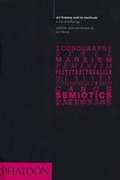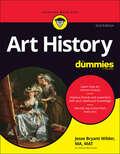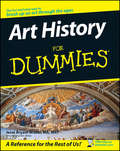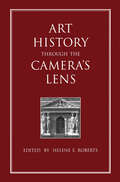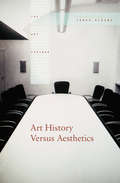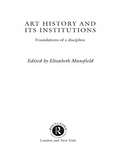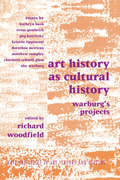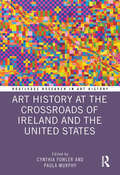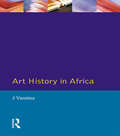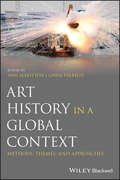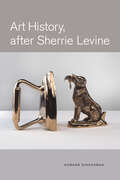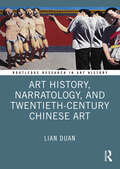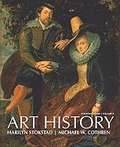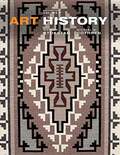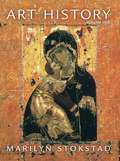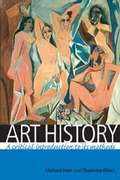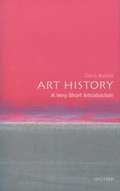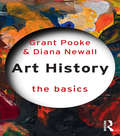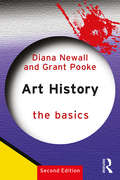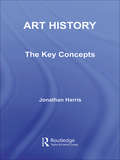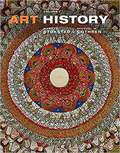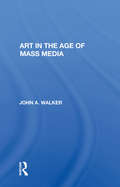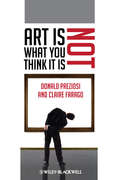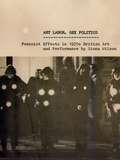- Table View
- List View
Art History And Its Methods
by Eric FernieApproaches to the history of art are probably more varied - and more debated than in any other branch of history, and a study of different historical approaches is becoming an increasingly important component of many academic courses. This anthology of art-historical writings from the Renaissance to the present day has a particular focus, for key texts have been chosen in which the authors themselves reflects on the nature of their subject and on their own methods of inquiry. Included are texts by Vasari, Winckelmann, Burckhardt, Wolfflin, Panofsky, Gombrich and Pollock, among others. The introduction gives a summary of art-historical methods, and each of the texts is accompanied by a brief commentary which places it in context and discusses the issues it raises. Also provided is a critical glossary of art-historical terms, a brief biography of each of the historians, and a select bibliography.
Art History For Dummies
by Jesse Bryant WilderReady to discover the fascinating world of art history? Let’s (Van) Gogh! Fine art might seem intimidating at first. But with the right guide, anyone can learn to appreciate and understand the stimulating and beautiful work of history’s greatest painters, sculptors, and architects. In Art History For Dummies, we’ll take you on a journey through fine art from all eras, from Cave Art to the Colosseum, and from Michelangelo to Picasso and the modern masters. Along the way, you’ll learn about how history has influenced art, and vice versa. This updated edition includes: Brand new material on a wider array of renowned female artists Explorations of the Harlem Renaissance, American Impressionism, and the Precisionists Discussions of art in the 20th and 21st centuries, including Dadaism, Constructivism, Surrealism, and today’s eclectic art scene Is there an exhibition in your town you want to see? Prep before going with Art History For Dummies and show your friends what an Art Smartie you are. An unbeatable reference for anyone looking to build a foundational understanding of art in a historical context, Art History For Dummies is your personal companion that makes fine art even finer!
Art History For Dummies
by Jesse Bryant Wilder MA, MATArt history is more than just a collection of dates and foreign-sounding names, obscure movements and arcane isms. Every age, for the last 50,000 years has left its unique imprint on the world, and from the first cave paintings to the ceiling of the Sistine Chapel, from the Byzantine mosaics of the Hagia Sophia, to the graffiti-inspired paintings of Jean-Michel Basquiat, art history tells the story of our evolving notions of who and what we are and our place in the universe.Whether you're an art enthusiast who'd like to know more about the history behind your favorite works and artists, or somebody who couldn't tell a Titian and a De Kooning--but would like to--Art History For Dummies is for you. It takes you on a tour of thirty millennia of artistic expression, covering the artistic movements, major artists, and indispensable masterworks, and the world events and cultural trends that helped spawn them. With the help of stunning black-and-white photos throughout, and a sixteen-page gallery of color images, it covers:The rise and fall of classical art in Greece and RomeThe differences between Renaissance art and MannerismHow the industrial revolution spawned RomanticismHow and why Post-Impression branched off from ImpressionismConstructivism, Dadaism, Surrealism and other 20th century ismsWhat's up with today's eclectic art sceneArt History For Dummies is an unbeatable reference for anyone who wants to understand art in its historical context.
Art History Through the Camera's Lens (Documenting the Image #Vol. 2.)
by Helene E. RobertsPhotography of art has served as a basis for the reconstruction of works of art and as a vehicle for the dissemination and reinterpretation of art. This book provides the first definitive treatment of the subject, with essays from noted authorities in the fields of art history, architecture, and photography. The essays explore the many meanings of photography as documentation for the art historian, inspiration for the artist, and as a means of critical interpretation of works of art. Art History Through the Camera's Lens will be important reading for students, historians, librarians, and curators of the visual arts.
Art History Versus Aesthetics (The Art Seminar #Vol. 1)
by James ElkinsIn this unprecedented collection, over twenty of the world's most prominent thinkers on the subject including Arthur Danto, Stephen Melville, Wendy Steiner, Alexander Nehamas, and Jay Bernstein ponder the disconnect between these two disciplines. The volume has a radically innovative structure: it begins with introductions, and centres on an animated conversation among ten historians and aestheticians. That conversation was then sent to twenty scholars for commentary and their responses are very diverse: some are informal letters and others full essays with footnotes. Some think they have the answer in hand, and others raise yet more questions. The volume ends with two synoptic essays, one by a prominent aesthetician and the other by a literary critic. This stimulating inaugural volume in the Routledge The Art Seminar series presents not one but many answers to the question; Does philosophy have anything to say to art history?
Art History and Its Institutions: The Nineteenth Century
by Elizabeth MansfieldArt History and Its Institutions focuses on the institutional discourses that shaped and continue to shape the field from its foundations in the nineteenth century. From museums and universities to law courts, labour organizations and photography studios, contributors examine a range of institutions, considering their impact on movements such as modernism; their role in conveying or denying legitimacy; and their impact on defining the parameters of the discipline.
Art History as Cultural History: Warburg's Projects (Critical Voices in Art, Theory and Culture)
by Richard WoodfieldThis book focuses on Aby Warburg (1866-1929), one of the legendary figures of twentieth century cultural history. His collection, which is now housed in the Warburg Institute of the University of London bears witness to his idiosyncratic approach to a psychology of symbolism, and explores the Nachleben of classical antiquity in its manifold cultural legacy. This collection of essays offers the first translation of one of Warburg's key essays, the Gombrich lecture, described by Carlo Ginzburg as 'the richest and most penetrating interpretation of Warburg' and original essays on Warburg's astrology, his Mnemosyne project and his favourite topic of festivals. Richard Woodfield is Research Professor in the Faculty of Art and Design at the Nottingham Trent University, England. He has edited E.H Gombrich's Reflections on the History of Art (1987), Gombrich on Art and Psychology (1996), The Essential Gombrich (1996), and a volume on Riegl in the Critical Voices in Art, Theory and Culture series. He is also the General Editor of a new series of books for G+B Arts International, Aesthetics and the Arts. Edited by Richard Woodfield, Research Professor in the Faculty of Art and Design at Nottingham Trent University, UK.
Art History at the Crossroads of Ireland and the United States (Routledge Research in Art History)
by Cynthia Fowler Paula MurphyTaking the visual arts as its focus, this anthology explores aspects of cultural exchange between Ireland and the United States. Art historians from both sides of the Atlantic examine the work of artists, art critics and art promoters. Through a close study of selected paintings and sculptures, photography and exhibitions from the nineteenth century to the present, the depth of the relationship between the two countries, as well as its complexity, is revealed. The book is intended for all who are interested in Irish/American interconnectedness and will be of particular interest to scholars and students of art history, visual culture, history, Irish studies and American studies.
Art History at the Crossroads of Ireland and the United States (Routledge Research in Art History)
by Cynthia Fowler Paula MurphyTaking the visual arts as its focus, this anthology explores aspects of cultural exchange between Ireland and the United States. Art historians from both sides of the Atlantic examine the work of artists, art critics and art promoters. Through a close study of selected paintings and sculptures, photography and exhibitions from the nineteenth century to the present, the depth of the relationship between the two countries, as well as its complexity, is revealed. The book is intended for all who are interested in Irish/American interconnectedness and will be of particular interest to scholars and students of art history, visual culture, history, Irish studies and American studies.
Art History in Africa: An Introduction to Method
by J. VansinaThis is a pioneering introduction to a subject that is still at an early srage of academic development. It aims to provide the reader with a systematic method for the historical understanding of African art. Professor Vansina considers the medium, technique, style and meaning of art objects and examines the creative process through which they come into being. Numerous photographs and drawings illustrate his arguments, and help to explain the changes that have taken place.
Art History in a Global Context: Methods, Themes, and Approaches
by Ann Albritton and Gwen FarrellyPresents a clear and comprehensive introduction to the evolving discipline of global art studies This volume examines how art historians, critics, and artists revisit art from ancient times through to the early modern period as well as the ways in which contemporary objects are approached through the lens of global contact, exchange, networks, and trade routes. It assists students who actively seek to understand "global art history" and the discipline beyond the founding Western canons. The first section of Art History in a Global Context: Methods, Themes and Approaches explores how themes related to globalization are framing the creation, circulation, reception, and study of art today. The second section examines how curators, scholars, artists, and critics have challenged the Eurocentric canon through works of art, writings, exhibitions, biennials, large-scale conferences, and the formation of global networks. The third section is designed to help students look forward by exploring how art history in a global context is beginning to extend beyond the contemporary condition to understand the meaning, conditions, and impacts of exchange across borders and among artists in earlier periods. Presents a historiography of global art histories in academic, museological, and exhibition projects Written by a collection of authors from different linguistic, cultural, geographic, generational, and disciplinary perspectives Aids students in understanding “global art history” and the discipline beyond the founding Western canons Provides a set of case studies to bring to life methodologies being employed in the field Features contributors from the program of the Getty Foundation and the College Art Association International Committee’s project Art History in a Global Context is an ideal choice for upper-level undergraduate and entry level graduate art students. It can also be used as a teaching tool, or as models for case studies in different formats.
Art History, After Sherrie Levine
by Howard SingermanThis book examines the career of New York-based artist Sherrie Levine, whose 1981 series of photographs "after Walker Evans"—taken not from life but from Evans’s famous depression-era documents of rural Alabama—became central examples in theorizing postmodernism in the visual arts in the 1980s. For the first in-depth examination of Levine, Howard Singerman surveys a wide variety of sources, both historical and theoretical, to assess an artist whose work was understood from the outset to challenge both the label "artist" and the idea of oeuvre—and who has over the past three decades crafted a significant oeuvre of her own. Singerman addresses Levine’s work after Evans, Brancusi, Malevich, and others as an experimental art historical practice—material reenactments of the way the work of art history is always doubled in and structured by language, and of the ways the art itself resists.
Art History, Narratology, and Twentieth-Century Chinese Art (Routledge Research in Art History)
by Lian DuanThis study constructs a framework of narratology for art history and rewrites the development of twentieth-century Chinese art from a narratological perspective. Theoretically and methodologically oriented, this is a self-reflective meta-art history studying the art historical narratives while narrating the story of modern and contemporary Chinese art. Thus, this book explores the three layers of narrative within the narratological framework: the first-hand fabula, the secondary narration, and the tertiary narrativization. With this tertiary narrativization, the reader-author presents three types of narrative: the grand narrative of the central thesis of this book, the middle-range narrative of the chapter theses, and case analyses supporting these theses. The focus of this tertiary narrativization is the interaction between Western influence on Chinese art and the Chinese response to this influence. The central thesis is that this interaction conditioned and shaped the development of Chinese art at every historical turning point in the twentieth century. The book will be of interest to scholars working in art history, critical theory, Chinese studies, and cultural studies.
Art History, Volume 2
by Marilyn Stokstad Michael CothrenART HISTORY provides students with the most student-friendly, contextual, and inclusive art history survey text on the market. These hallmarks make ART HISTORY the choice for instructors who seek to actively engage their students in the study of art. This new edition of ART HISTORY is the result of a happy and productive collaboration between two scholar-teachers (Marilyn Stokstad and Michael Cothren) who share a common vision that survey courses on the history of art should be filled with as much enjoyment as erudition, and that they should foster an enthusiastic, as well as an educated, public for the visual arts. Like its predecessors, this new edition seeks to balance formal and iconographic analysis with contextual art history in order to craft interpretations that will engage a diverse student population. Throughout the text, the visual arts are treated as part of a larger world, in which geography, politics, religion, economics, philosophy, social life, and the other fine arts are related components of a vibrant and cultural landscape.
Art History, Volume 2
by Marilyn Stokstad Michael W. CothrenArt history--what a fascinating and fluid discipline, which evolves as the latest research becomes available for debate and consider¬ation. The sixth edition of Art History has been revised to reflect such new discoveries, recent research, and fresh interpretive perspec¬tives, and also to address the changing needs of the audience--both students and educators. With these goals in mind and by incorporat¬ing feedback from our many users and reviewers, we have sought to make this edition an improvement in sensitivity, readability, and accessibility without losing anything in comprehensiveness, in scholarly precision, or in its ability to engage readers. To facilitate student learning and understanding of art his¬tory, the sixth edition is centered on six key Learning Objectives. These overarching goals helped steer and shape this revision with their emphasis on the fundamental reasons we teach art history to undergraduates, and they have been repeated at the beginning of each chapter, tailored to the subject matter in that section of the book so that the student will be continually reminded of the goals and objectives of the study of art history.
Art History, Volume One
by Marilyn StokstadIn tune with today's readers, this is the art history book of choice for a new generation. Presenting a broad view of art from prehistory through the Gothic Age, it sympathetically and positively introduces the works of all artists. This includes women, artists of color, and the arts of other continents and regions, as well as those of Western Europe and the United States. The new edition contains even more full-color reproductions, larger images, redrawn maps and timelines, and new photographs and higher quality images. Balancing both the traditions of art history and new trends of the present, Art History is the most comprehensive, accessible, and magnificently illustrated work of its kind.Broad in scope and depth, this beautifully illustrated work features art from the following time periods and places: prehistory; art of the ancients (Near East, Egypt, the Aegean, Greece, Etruscan, and Roman); early Christian, Jewish, and Byzantine art; Islamic art; India before 1100; Chinese art before 1280; Japanese art before 1392; art of the Americas before 1300; the art of ancient Africa; early Medieval European art; Romanesque art, and Gothic art.An excellent reference work and beautiful edition for any visual artist.
Art History: A Critical Introduction to Its Methods
by Michael Hatt Charlotte KlonkThis book provides a lively and stimulating introduction to methodological debates within art history. Offering a lucid account of approaches from Hegel to post-colonialism, the book provides a sense of art history's history as a discipline from its emergence in the late-eighteenth century to contemporary debates. By explaining the underlying philosophical and political assumptions behind each method, along with clear examples of how these are brought to bear on visual and historical analysis, the authors show that an adherence to a certain method is, in effect, a commitment to a set of beliefs and values. The book makes a strong case for the vitality of the discipline and its methodological centrality to new fields such as visual culture. This book will be of enormous value to undergraduate and graduate students, and also makes its own contributions to ongoing scholarly debates about theory and method.
Art History: A Very Short Introduction
by Dana ArnoldThis clear and concise new introduction examines all the major debates and issues using a wide range of well-known examples. It discusses the challenge of using verbal and written language to analyse a visual form. Dana Arnold also examines the many different ways of writing about art, and the changing boundaries of the subject of art history. Topics covered include the canon of Art History, the role of the gallery, 'blockbuster' exhibitions, the emergence of social histories of art (Feminist Art History or Queer Art History, for example), the impact of photography, and the development of Art History using artefacts such as the altarpiece, the portrait, or pornography, to explore social and cultural issues such as consumption, taste, religion, and politics. Importantly, this book explains how the traditional emphasis on periods and styles originates in western art production and can obscure other critical approaches, as well as art from non western cultures.
Art History: Teach Yourself Ebook (The Basics)
by Grant Pooke Diana NewallArt History: The Basics is a concise and accessible introduction for the general reader and the undergraduate approaching the history of art for the first time at college or university. It will give you answers to questions like: What is art and art history? What are the main methodologies used to understand art? How have ideas about form, sex and gender shaped representation? What connects art with psychoanalysis, semiotics and Marxism? How are globalization and postmodernism changing art and art history? Each chapter introduces key ideas, issues and debates in art history, including information on relevant websites and image archives. Fully illustrated with an international range of artistic examples, Art History: The Basics also includes helpful subject summaries, further ideas for reading in each chapter, and a useful glossary for easy reference.
Art History: The Basics (The Basics)
by Grant Pooke Diana NewallNow in its second edition, this volume is an accessible introduction to the history of art. Using an international range of examples, it provides the reader with a toolkit of concepts, ideas and methods relevant to understanding art history. This new edition is fully updated with colour illustrations, increased coverage of non-western art and extended discussions of contemporary art theory. It introduces key ideas, issues and debates, exploring questions such as: What is art and what is meant by art history? What approaches and methodologies are used to interpret and evaluate art? How have ideas regarding medium, gender, identity and difference informed representation? What perspectives can psychoanalysis, semiotics and social art histories bring to the study of the discipline? How are the processes of postcolonialism, decolonisation and globalisation changing approaches to art history? Complete with helpful subject summaries, a glossary, suggestions for future reading and guidance on relevant image archives, this book is an ideal starting point for anyone studying art history as well as general readers with an interest in the subject.
Art History: The Key Concepts (Routledge Key Guides)
by Jonathan HarrisArt History: The Key Concepts is a systematic, reliable and accessible reference guide to the disciplines of art history and visual culture. Containing entries on over 200 terms integral to the historical and theoretical study of art, design and culture in general, it is an indispensable source of knowledge for all students, scholars and teachers. Covering the development, present status and future direction of art history, entries span a wide variety of terms and concepts such as abstract expressionism, epoch, hybridity, semiology and zeitgeist. Key features include: a user-friendly A-Z format fully cross-referenced entries suggestions for further reading. Engaging and insightful, as well as easy to follow and use, Art History: The Key Concepts builds a radical intellectual synthesis for understanding and teaching art, art history and visual culture.
Art History: Volume 1
by Marilyn Stokstad Michael W. CothrenArt History brings the history of art to life for a new generation of students. It is global in scope, inclusive in its coverage, and warm and welcoming in tone. The guiding vision of Art History is that the teaching of art history survey courses should be filled with equal delight, enjoyment, and serious learning, while fostering an enthusiastic and educated public for the visual arts. The Sixth Edition has been revised to reflect new discoveries, recent research, and fresh interpretive perspectives, as well as to address the changing needs of both students and educators. Art History, Sixth Edition is also available via Revel™, an interactive learning environment that enables students to read, practice, and study in one continuous experience.
Art In The Age Of Mass Media
by John WalkerCan fine art survive in an age of mass media? If so, in what forms and to what purpose? And can radical art still play a critical role in today's divided world? These are the questions addressed in the Art in the Age of Mass Media, as John Walker examines the fascinating relationship between art and mass media, and the myriad interactions between h
Art Is Not What You Think It Is (Wiley-Blackwell Manifestos #73)
by Donald Preziosi Claire FaragoArt Is Not What You Think It Is utilizes original research to present a series of critical incursions into the current state of debate on the idea of art, making manifest what has been largely missing or unsaid in those discussions. Links museology, history, theory, and criticism to the realities of contemporary social conditions and shows how they have structurally functioned in a variety of contexts Deals with divisive and controversial problems such as blasphemy and idolatry, and the problem of artistic truth Addresses relations between European notions about art and artifice and those developed in other and especially indigenous cultural traditions
Art Labor, Sex Politics: Feminist Effects in 1970s British Art and Performance
by Siona WilsonContrary to critics who have called it the &“undecade,&” the 1970s were a time of risky, innovative art—and nowhere more so than in Britain, where the forces of feminism and labor politics merged in a radical new aesthetic. In Art Labor, Sex Politics Siona Wilson investigates the charged relationship of sex and labor politics as it played out in the making of feminist art in 1970s Britain. Her sustained exploration of works of experimental film, installation, performance, and photography maps the intersection of feminist and leftist projects in the artistic practices of this heady period.Collective practice, grassroots activism, and iconoclastic challenges to society&’s sexual norms are all fundamental elements of this theoretically informed history. The book provides fresh assessments of key feminist figures and introduces readers to less widely known artists such as Jo Spence and controversial groups like COUM Transmissions. Wilson&’s interpretations of two of the best-known (and infamous) exhibitions of feminist art—Mary Kelly&’s Post-Partum Document and COUM Transmissions&’ Prostitution—supply a historical context that reveals these works anew. Together these analyses demonstrate that feminist attention to sexual difference, sex, and psychic formation reconfigures received categories of labor and politics.How—and how much—do sexual politics transform our approach to aesthetic debates? What effect do the tropes of sexual difference and labor have on the very conception of the political within cultural practice? These are the questions that animate Art Labor, Sex Politics as it illuminates an intense and influential decade of intellectual and artistic experimentation.
